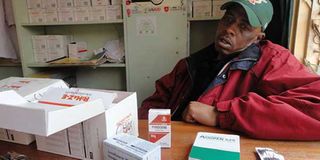Shorter treatment period for TB using heavy doses of same drugs

A patient at a TB clinic. Patients with drug-resistant tuberculosis can now breathe a sigh of relief following the government’s adoption of a shorter treatment period. PHOTO | FILE | NATION MEDIA GROUP
What you need to know:
- Whereas the timeline has reduced by half, the cocktail of drugs has not.
- According to TB experts, the drugs can achieve the same cure rate whether taken for two years or nine months.
- The shorter treatment will be administered only to newly enrolled patients and not those who have been on the old model.
Patients with drug-resistant tuberculosis can now breathe a sigh of relief following the government’s adoption of a shorter treatment period.
Whereas the timeline has reduced by half, the cocktail of drugs has not — the same drugs will be taken but for a shorter time.
This is because, according to TB experts, the drugs can achieve the same cure rate whether taken for two years or nine months.
On Wednesday, the Ministry of Health said it had introduced patients with multi drug resistant tuberculosis to a shorter treatment time of between nine months and one year, from the current two years.
PHASED OUT
The ministry also phased out the older regime drugs.
This means health workers will be able to reduce or mitigate the adverse drug re-actions patients endure while using the aggressive medicines.
“Attempts to reduce the length of treatment and to use a combination of tolerable drugs have been going on for several years,” said Dr Enos Masini, who heads the tuberculosis programme at the World Health Organisation (WHO, Kenya) office.
Dr Masini, however, added that the shorter treatment will be administered only to newly enrolled patients and not those who have been on the old model.
“We cannot just switch drugs to the newer regimen. Once you are on the older model, you should finish that treatment,” he advised.
BANGLADESH REGIMEN
The shorter treatment is known as the Bangladesh regimen, after the country its effectiveness was first tested and proven. The regimen has been adopted by some West African countries, Dr Masini added.
The new drugs are deemed to be cheaper and potentially more effective than conventional ones. The regimen was adopted by WHO in May 2016. Approval of the treatment locally took place last year and was officially rolled out in October.
REDUCE BY HALF
Explaining the concept, Dr Masini said: “Currently, patients with drug-resistant TB take approximately 14,000 pills within 20 to 24 months, at a cost of Sh1.5 million. With the new recommendations, the duration will reduce by half, to the relief of patients, the government and donors. The new drugs have less side effects.”
Previously, patients received four to five different injections and oral tablets. But now they will get the same drugs for four months, after which the injections will be stopped. They will continue with oral drugs for five months.
“With shorter treatment plans, the side effects will be less. This new regimen comes with an active drug safety monitoring where health workers will look out for drug reactions early enough and mitigate any problem,” he said.
SIDE EFFECT
A key side effect of TB medication is loss of hearing. Dr Masini said health workers will now detect this early enough.
“Hearing tests will be conducted before medication starts. Patients will be monitored and their drugs switched if we notice signs of hearing loss,” he said.
Tuberculosis is caused by bacteria that spread from person to person through the air.
The disease usually affects the lungs, but it can also infect the brain, kidneys, spine and other parts of the body.
In most cases, TB is treatable and curable; but it is highly lethal if one does not get proper treatment.
Sometimes, infections are caused by bacteria that are resistant to two of the most powerful first-line anti-TB drugs — isoniazid and rifampicin. This type of TB is known as multi-drug-resistant tuberculosis (MDR-TB).
It results mainly from mismanagement of TB treatment and person-to-person transmission. Most people with TB are cured by a strict six-month drug regimen.
Additional reporting by Millicent Mwololo






